A tail is a common characteristic of organisms that belong to the animal kingdom (excluding birds, of course). Only very few animals, like humans and gorillas, do not have tails. But what about hamsters? Do hamsters have tails? Do hamsters need tails? Can you remove a hamster’s tail? Read this blog post to find out.
But before diving in and finding out if hamsters have tails, let’s understand why some animals have tails and others don’t.
Why do animals have tails?
Unlike eyes, which help animals see, wings, which help birds fly, and gills, which help fish breathe, tails do not serve a single purpose but a multitude of purposes. Different groups of animals have evolved physically and socially to use their tails in different ways (Source: Britannica). Let’s look at some of these uses below:
1. Speed boosters
In vertebrates like fish and crocodiles, tails propel the animals forward, giving them a great burst of speed.
2. Stabilizers
In many animals, tails provide balance and stability when the animal is stationary or in motion. The large Sauropod dinosaurs had long tails to balance their long necks. In wild animals like cheetahs, tails provide stability at high speeds (See the video below).
3. Stingers and chemical weapons
In some insects, like the scorpion, the tail delivers a lethal dose of poison to their prey or enemy.
4. Decoys
Some reptiles, like lizards, can detach their tails voluntarily when a predator attacks them from behind. The detached tail continues to wiggle for up to 30 minutes, distracting the predator and thus helping the lizards escape. They can regenerate their tails later over a period of six months to a year.
5. Support during climbing
Some animals, like monkeys and squirrels, use their tails to hold on to branches, thus improving their ability to maneuver through trees.
6. Protection against insects
Some animals, like cows, use their tails to swat flies.
7. Attracting the opposite sex
Some birds, like peacocks and turkeys with colorful tail feathers, use their tails to attract mates.
8. Heat loss
The tails of some rodents, like rats, can help control the body temperature.
The body of human beings can control the body temperature by sweating. But rodents don’t have sweat glands. So they can’t sweat like us. But rats’ tails, which don’t have any hair on them, can dissipate body heat quickly.
Rats can even control the blood vessels that lead to their hairless tails. When it is too hot, they can open up their blood vessels, letting more blood flow into their tails, thus dissipating their body heat. When it gets too cold, they can constrict these blood vessels, thereby preventing the blood from flowing into their tails and preserving heat.
Do hamsters have tails?
After reading the above section, you may notice that many of the above uses do not apply to hamsters. But like rats, hamsters also do not have sweat glands to dissipate their body heat. So, it would be beneficial for them to have long tails. But is that how they evolved? Let’s find out.
Do hamsters have tails?
Long story short, yes, hamsters do have tails. But not all hamster species have the same ratio of head + body length to tail length. So, let’s look at the different species of hamsters and find out if they have tails and how long their tails are.
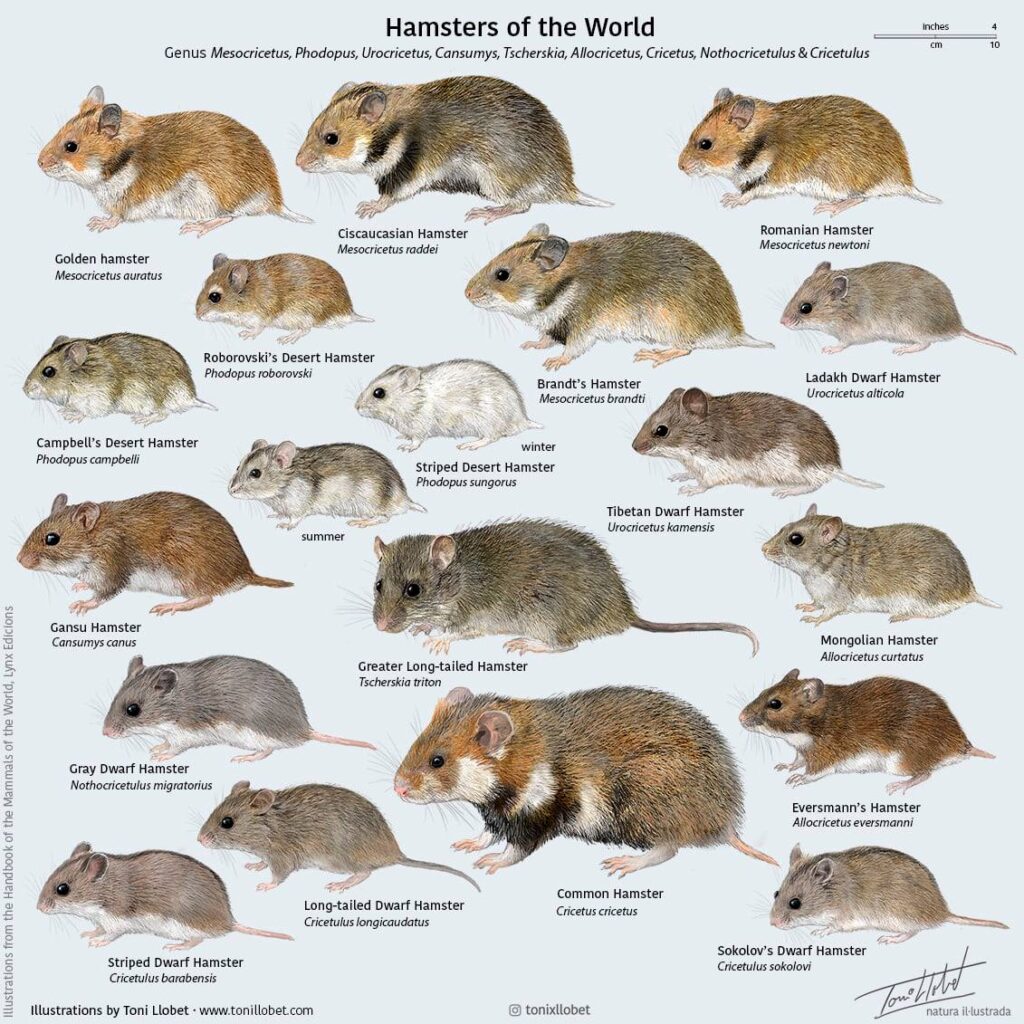
(Source: Facebook)
Instead of first looking at all the pet hamsters and then looking at wild hamsters, I have decided to classify the hamsters based on genus so that it is easier to understand how hamsters belonging to the same genus often have similar tail lengths.
Genus Mesocricetus
There are four hamster species in this genus. Let’s find out if the hamster species in this genus have tails.
Do Syrian hamsters have tails?

Yes, they have tails. Syrian hamsters are one of the five hamster species most commonly kept as pets.
They are the biggest pet hamsters. They can get up to 9 inches in length. However, their tails are way too small compared to their body size. Their short, stubby tails don’t even reach 0.5 inches in length. If you have a Long-haired Syrian hamster, the tail may even be completely hidden.
Do Turkish hamsters have tails?

Even though they are closely related to the Syrian hamsters, Turkish hamsters are smaller and have quite small tails. They are also much more aggressive than Syrian hamsters.
Do Romanian hamsters have tails?

Yes, they have tails. Adult Romanian hamsters can reach a head + body length of 7 inches and a tail length of 0.9 inches (Source: Global Biodiversity Information Facility).
Do Ciscaucasian hamsters have tails?
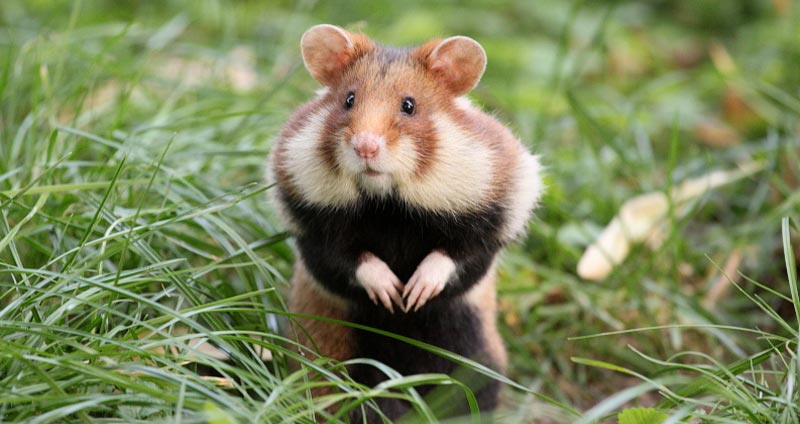
Yes, Ciscaucasian hamsters also have tails. Like Syrian hamsters, they are also big hamsters that can reach up to 11 inches in length. But their tails are very short, reaching just 0.59 inches in length (Source: Wikipedia).
As you can see above, the hamsters of the genus Mesocricetus are larger than other hamster species. But they have short tails that don’t even reach 15% of their body lengths.
Genus Cricetus
Only one hamster species falls under this genus. Let’s find out if they have tails.
Do European hamsters have tails?

Yes, they have tails.
Bigger than all pet hamster species, the European hamster can reach a length of 14 inches when fully grown. Their tails can reach a length of 2.4 inches.
Genus Phodopus
There are three hamster species in this genus. All of them are kept as pets. Let’s find out if the members of this genus have tails.
Do Roborovski hamsters have tails?

Yes, they have tails.
Roborovski hamsters are the smallest hamster species but also the fastest. They can run up to six miles in the wild in a single night. That’s how active they are. Roborovski hamsters can reach a length of 2 inches in adulthood. But their tails reach only a length of 0.125 inches.
Do Campbell hamsters have tails?

Yes, Campbell dwarf hamsters also have tails.
Campbell hamsters are far smaller than Syrian hamsters. So, they are called dwarf hamsters. They can reach a length of 4 inches in adulthood. Their tails can reach a length of 0.3 inches.
Do Winter White hamsters have tails?

Yes, like the other pet hamster species, Winter White hamsters also have tails.
Winter White hamsters are comparatively smaller than Syrian hamsters. So, they are called dwarf hamsters. They reach a length of 3 inches when fully grown. Their tails can reach a length of up to 0.6 inches.
The hamsters in this genus are pretty small compared to the previous genus. But just like the previous genus, they also have short tails. Except for Winter White hamsters, whose tails reach almost 20% of their head + body lengths, the tails of other hamsters don’t even reach 10% of their head + body lengths.
Genus Nothocricetulus
There is only one hamster species in this genus – The Grey dwarf hamster. Let’s find out if they have tails.
Do Grey dwarf hamsters have tails?

Yes, they have tails.
Grey dwarf hamsters are smaller in size compared to Syrian hamsters. So, they are called dwarf hamsters. They can grow up to 4.7 inches in length. Their tails can reach a length of up to 1.5 inches (Source: Wikipedia). So, they have long tails when compared to many pet hamster species.
Genus Cricetulus
Just like the previous genus, the hamsters that belong to this genus are also quite small compared to Syrian hamsters. Let’s find out how long the tails of the hamster species in this genus are.
Do Chinese hamsters have tails?
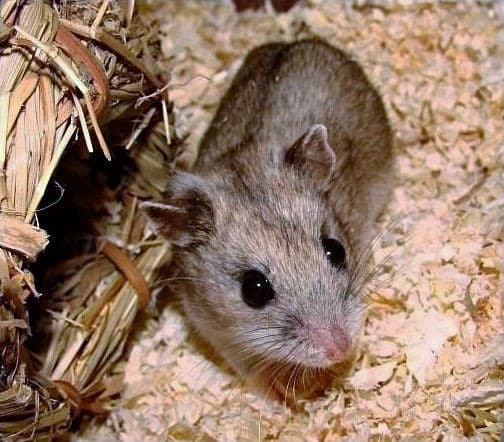
Yes, they have tails. Chinese dwarf hamsters are one of the five hamster species most commonly kept as pets.
Chinese hamsters are dwarf hamsters, i.e., they are far smaller in size when compared to a Syrian hamsters. They can reach up to five inches in length when fully grown. Chinese hamsters have the longest tails among all pet hamsters. In this sense, they resemble a rat much more than a hamster. Their tails can reach a length of one inch.
Contrary to what most websites site, Chinese hamsters don’t have tails that are almost as long as their body, but only 1/5th their body length (Source: Wikipedia).
Do Chinese striped hamsters have tails?
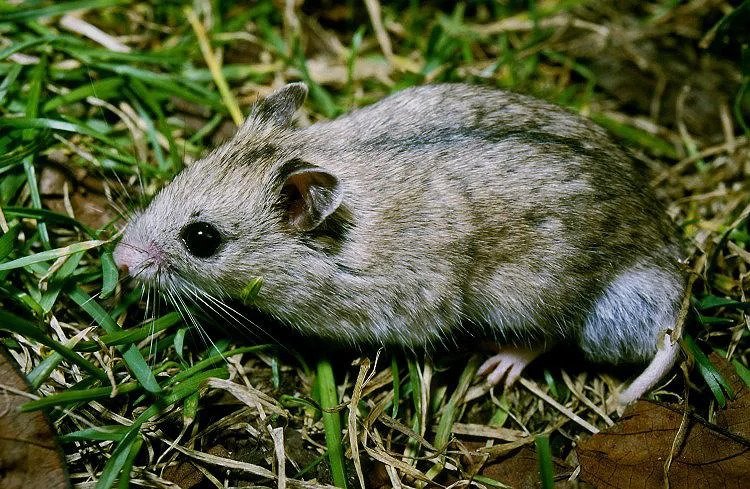
Yes, Chinese striped hamsters have tails. Adult Chinese striped hamsters can be up to 4.6 inches long with a 1-inch long tail.
Do Tibetan dwarf hamsters have tails?
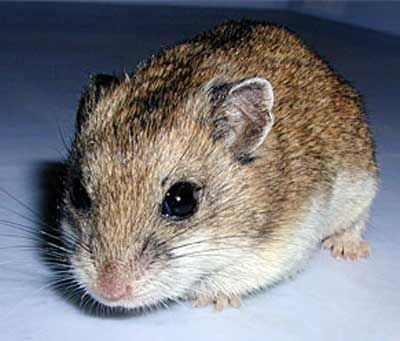
Yes, they have tails.
Like other dwarf hamsters, Tibetan dwarf hamsters are pretty small compared to Syrian hamsters. They can grow and reach a length of just 4.1 inches. In addition to that, their tails can also be 1.5 inches long.
Do Kam dwarf hamsters have tails?

Yes, Kam dwarf hamsters have tails. They can reach a head and body length of 4.4 inches and a tail length of 2.5 inches upon reaching adulthood.
Do Sokolov’s dwarf hamsters have tails?

Yes, Sokolov’s dwarf hamsters have tails. They can grow up to 4.5 inches in length, with their tails reaching a maximum length of 1.26 inches.
Do Long-tailed dwarf hamsters have tails?
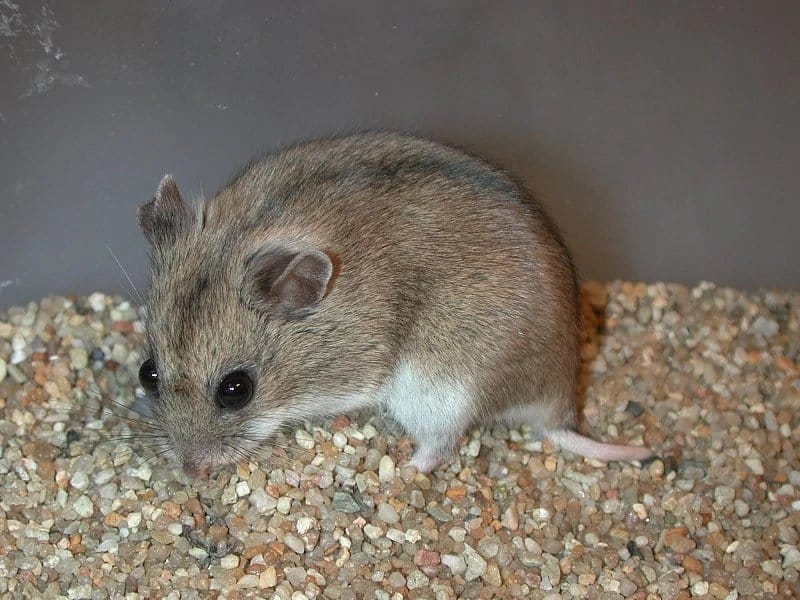
Yes, they have tails. The head+body length of a Long-tailed dwarf hamster can reach up to 5.31 inches in length, and its tail can reach up to 1/3rd of its body length (Source: Wikipedia).
As you can see, the tails of the hamsters in this genus can be between 20% to 50% of their body lengths.
Genus Allocricetulus
There are only two hamster species that belong to this genus. Let’s find out if these hamsters also have tails.
Do Mongolian hamsters have tails?
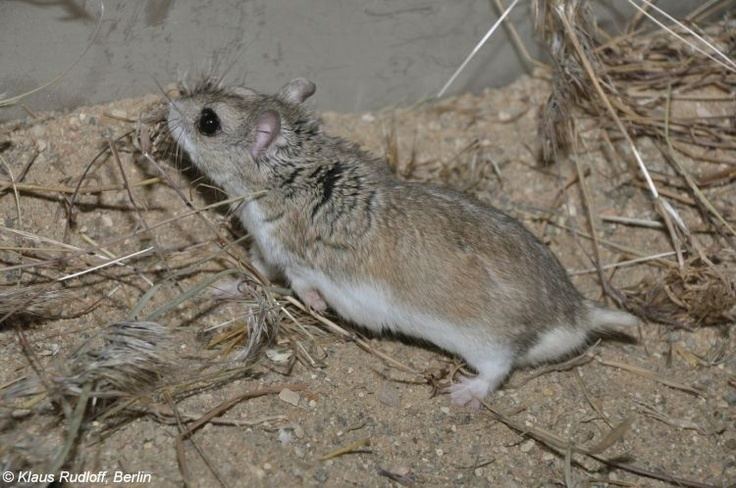
Yes, Mongolian hamsters have tails.
Mongolian hamsters are quite small when compared to Syrian hamsters. They reach a maximum length of just 5.1 inches when fully grown. Their tails can reach a maximum length of one inch when fully grown (Source: Zoo Tier Liste).
Do Evermann’s hamsters have tails?
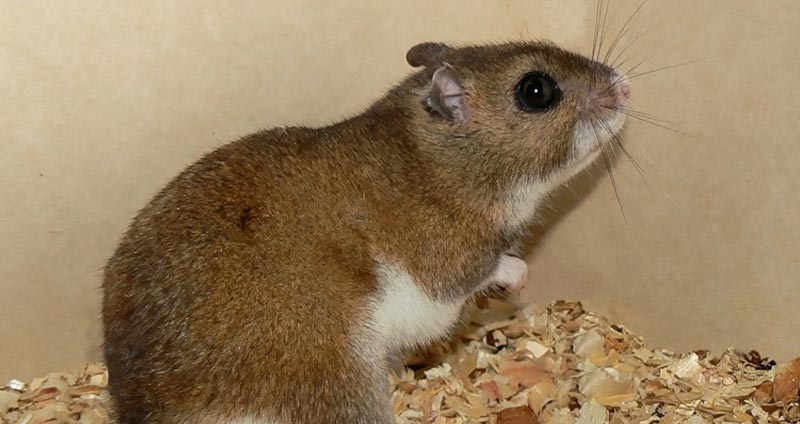
Yes, Evermann’s hamsters have tails. When fully grown, their head and body can reach a length of 6.3 inches, and their tails can reach a length of 1.1 inches (Source: Hamster Fandom).
The tail lengths of hamsters in this genus are not more than 20% of their body lengths.
Genus Tscherskia
The only hamster species that fall under this genus is the Greater Long-tailed hamster. Let’s find out if it has a tail.
Do Greater Long-tailed hamsters have tails?

Yes, Greater Long-tailed hamsters have tails. They can grow up to 8.6 inches in length. Their tails can reach a length of 4.17 inches (Source: Global Biodiversity Information Facility). So, Greater Long-tailed hamsters have pretty long tails when compared to most hamster species.
Genus Cansumys
This genus has only one hamster species under it – The Gansu hamster.
Do Gansu hamsters have tails?
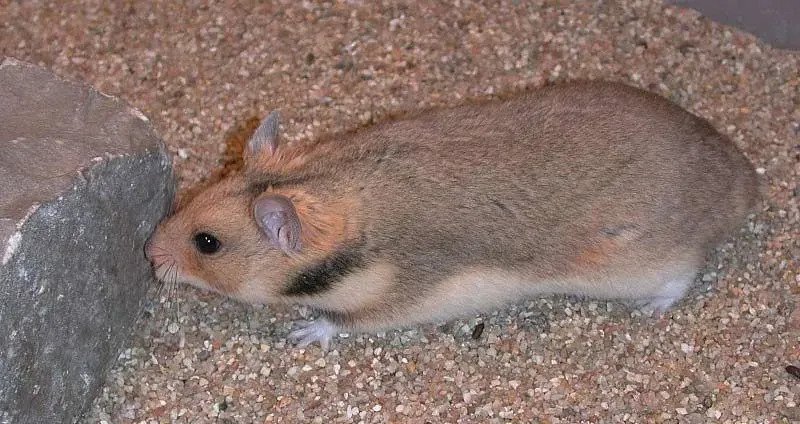
Yes, they have tails. They can grow up to just 5.5 inches in length, but how long their tails can get is unclear. But according to a reputable source, their tails can be up to 4.3 inches in length (Source: Global Biodiversity Information Facility).
So how long is a hamster’s tail? – The Verdict
From the above list of different hamster breeds, one thing is clear: Bigger hamsters (species) have shorter tails. But the same cannot be said about smaller hamsters. Some smaller hamsters have shorter tails, and some of them have longer tails as well. So, the length of a hamster’s tail depends on the type of hamster. But all pet hamsters have short tails.
So, let’s look at why hamsters (not all hamsters, but some of the species, at least) have short tails.
Why do hamsters have such short tails?
If you look at the entire list of hamsters, as explained above, you will notice that only two hamster species have tails that are more than 1/3rd of their body lengths – Greater long-tailed hamsters and Kam dwarf hamsters.
However, unlike hamsters, some of the other members of the rodent family have pretty long tails. Let’s look at a couple of rodents and find out how they compare to hamsters and why they have long tails and hamsters don’t.
Rats
Wikipedia defines rats as medium-sized, long-tailed rodents. But how big are rats’ tails actually? Let’s look at two of the most common rat species to understand.
- Black rats – Can reach up to 7.2 inches in head + body length, and the tail can reach a length of 8.7 inches (Source: Wikipedia).
- Brown rats – Can reach a head and body length of up to 11 inches, with their tail reaching a length of up to 9.5 inches (Source: Wikipedia).
Why do rats have long tails?
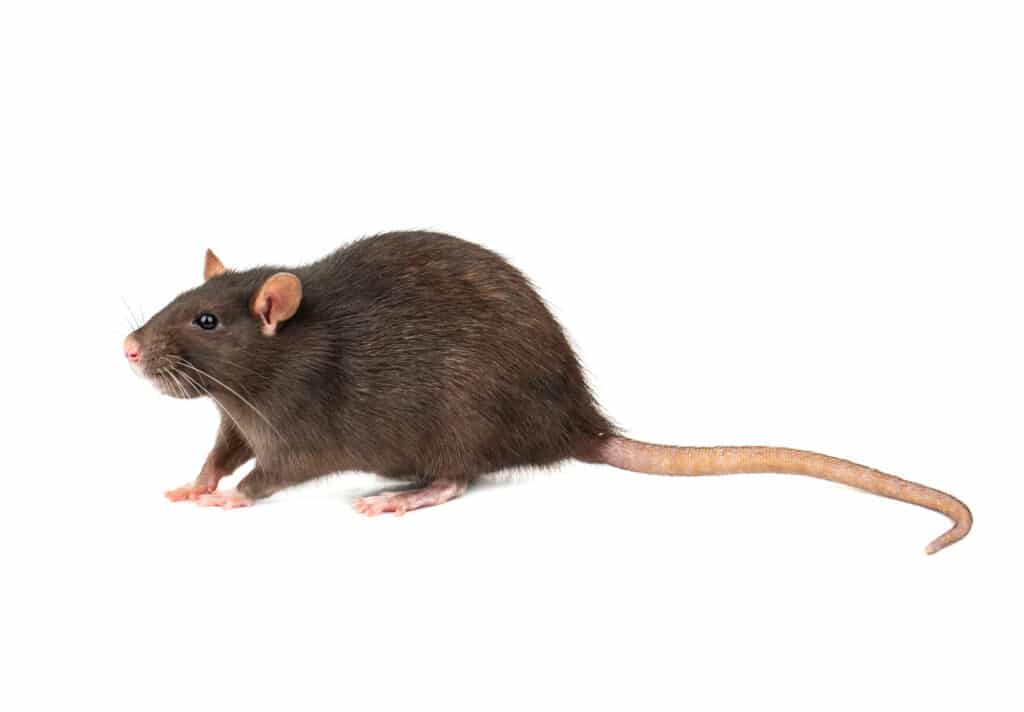
Rats like dark, warm places. But unlike hamsters, they don’t dig into the ground and build burrows unless absolutely necessary, i.e., if there is a way for them to survive without building burrows, they will opt for it.
Some rats even build nests on trees and roofs. But that is not to say that they never dig. Rats can dig burrows that can reach a depth of up to 18 inches.
But since rats can also live above the ground, climb trees, and move on narrow pathways like sewers, metal wires, etc., they have evolved long tails to help them balance.
Moreover, as mentioned above, rats use their tails to regulate their body temperature. A longer tail provides a larger surface area to dissipate body heat.
Rats can also use their tails to grip onto surfaces and push themselves upward for extra reach to grasp food.
Even though rats are born with long tails, a rare mutation causes some rats to be born without tails. These baby rats often die within a few days. In the rare case where some of them reach adulthood, they still develop health problems and face difficulty walking and running properly because of the absence of tails (Source: Automatic Trap).
Why do hamsters have shorter tails when compared to rats?
In contrast to rats, hamsters live in burrows deep under the ground, where temperature normally remains constant, unlike on the surface where temperatures fluctuate a lot (Several hamster species live in arid conditions and in deserts where days are hot and nights are cold). So, hamsters may not have needed tails to regulate their body temperatures.
Moreover, hamsters are creatures that run on the surface of the ground rather than climb on trees. So, they may not have needed a tail for balancing or gripping onto tree branches.
Therefore, a genetic mutation could have happened somewhere in history that created hamsters with shorter tails. These hamsters would have had an advantage in evolution, i.e., survived until reproduction, compared to hamsters with longer tails. As a result, hamsters could have evolved to have tails shorter than those of rats.
Gerbils
Gerbils are normally 6 to 12 inches in length, including their tail, which is almost 50% of their total length, i.e., the tails of gerbils are almost as long as their bodies (Source: Wikipedia).
Why do gerbils have long tails?
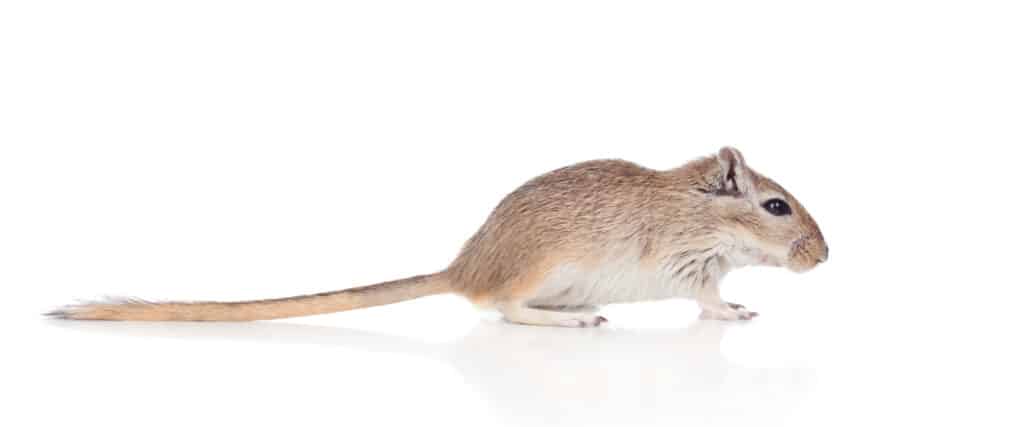
As explained above, gerbils have long tails, which are often as long as themselves, and these tails are multi-purposeful (Source: I Love Veterinary). A gerbil’s tail serves the following purposes:
A gerbil’s long tail helps it balance while running.
Like a rat’s tail, a gerbil’s tail also helps it lose heat and manage its body temperature effectively. In addition to that, some species of gerbils can store fat in their tail. Their bodies can then use this fat when food is scarce, thus helping them go longer periods without food.
Gerbils can also use their tails as a defense mechanism. Since they have long tails, predators can easily grab their tails. If that happens, they can slip/detach their tails and escape from the predator. Losing a tail can be pretty painful. Moreover, it can confuse the gerbil and affect its movement (Source: Rodent Zone). However, the gerbil will survive a predator attack, which is the most important thing in the wild.
Just like hamsters, gerbils live in burrows too. In the wild, gerbils live in groups of 2 to 15. So, they can beat their long tails against the ground to warn the other members of the family of an imminent danger.
Why do hamsters have tails shorter than those of gerbils?
When compared to gerbils, hamsters are not that much different. For example, they both live in burrows. But many species of hamsters are solitary. Some species may tolerate other members of their species if they have grown together since birth. So, they may not have needed long tails to warn other family members of danger.
At the beginning of their evolution, hamsters might have had long tails. But a genetic mutation could have occurred that created hamsters with short tails. Eventually, hamsters with long tails might have been eaten by predators (since their long tails make them easier targets), leaving only those hamsters with short tails to survive and reproduce. Thus, hamsters might have evolved to have shorter tails. (This is only my guess since land animals evolved from sea animals, which normally have big tails to help them swim and propel themselves underwater).
Do hamsters need tails?
To answer this question, we have to first understand if tails are necessary for a hamster’s survival in the wild.
Are Tails Necessary for Survival in the Wild?
If you have read this blog post until now, you might wonder if hamsters really need their tails at all. They may not need their tails for balance while running or support during climbing. They certainly don’t use their tails as chemical weapons or decoys as some animals do. So, having a tail may not provide a hamster any significant advantage for its survival in the wild.
The only reason why a hamster needs its tail is probably to attract its partner. Female hamsters raise their tails when they are around male hamsters and when they are ready to mate.
Most other pet websites claim that hamsters have small tails to help them burrow. But I don’t completely agree with that opinion because if that were the case, hamsters should have been completely tailless. But we know that some species of hamsters have tails that can be up to 50% of their body lengths. Moreover, other rodents, like gerbils, which are also burrowers like hamsters, do have pretty long tails. So, I don’t think many hamster species have small tails just because they are burrowers.
FAQ
Can a hamster lose his tail?
No, unlike gerbils, which can shed their tails when in danger, hamsters cannot do so. So, a hamster doesn’t normally lose its tail.
Can you pick a hamster using his tail?
No, you should never pick a hamster by his tail. A tail is just like any other organ for a hamster and can cause pain and injury to your hamster if not handled properly. Moreover, a tail is not strong enough to withstand the weight of the hamster. So, never pick your hamster using his tail.
Can you trim a hamster’s tail?
A tail is not something like a nail or hair that can regrow. Trimming it can cause extreme pain to your hamster. So, never trim your hamster’s tail.
What is a Wet Tail in Hamsters?
Wet Tail is a life-threatening disease in hamsters. It can be caused by stress, unhygienic situations, and improper diet. This disease is called Wet Tail because hamsters suffering from this disease have wetness around their back and tail due to diarrhea. Hamsters often die within 48 hours of contracting Wet Tail. So, providing proper food, keeping the cage clean, and avoiding stress are indispensable for your hamster to stay safe and healthy.
Do you have any other questions about your hamster’s tail? Let me know in the comments below and I will answer your questions.



